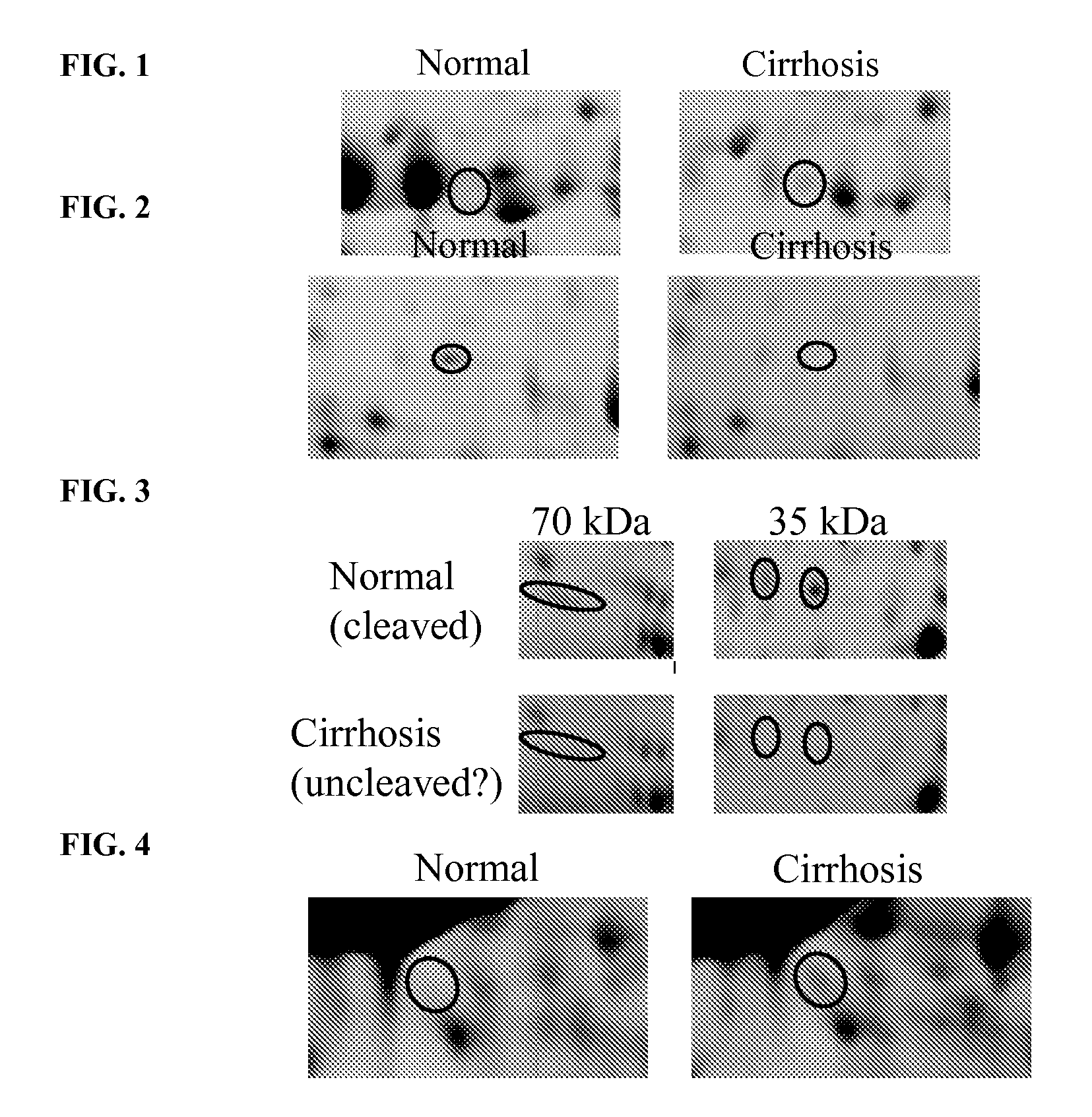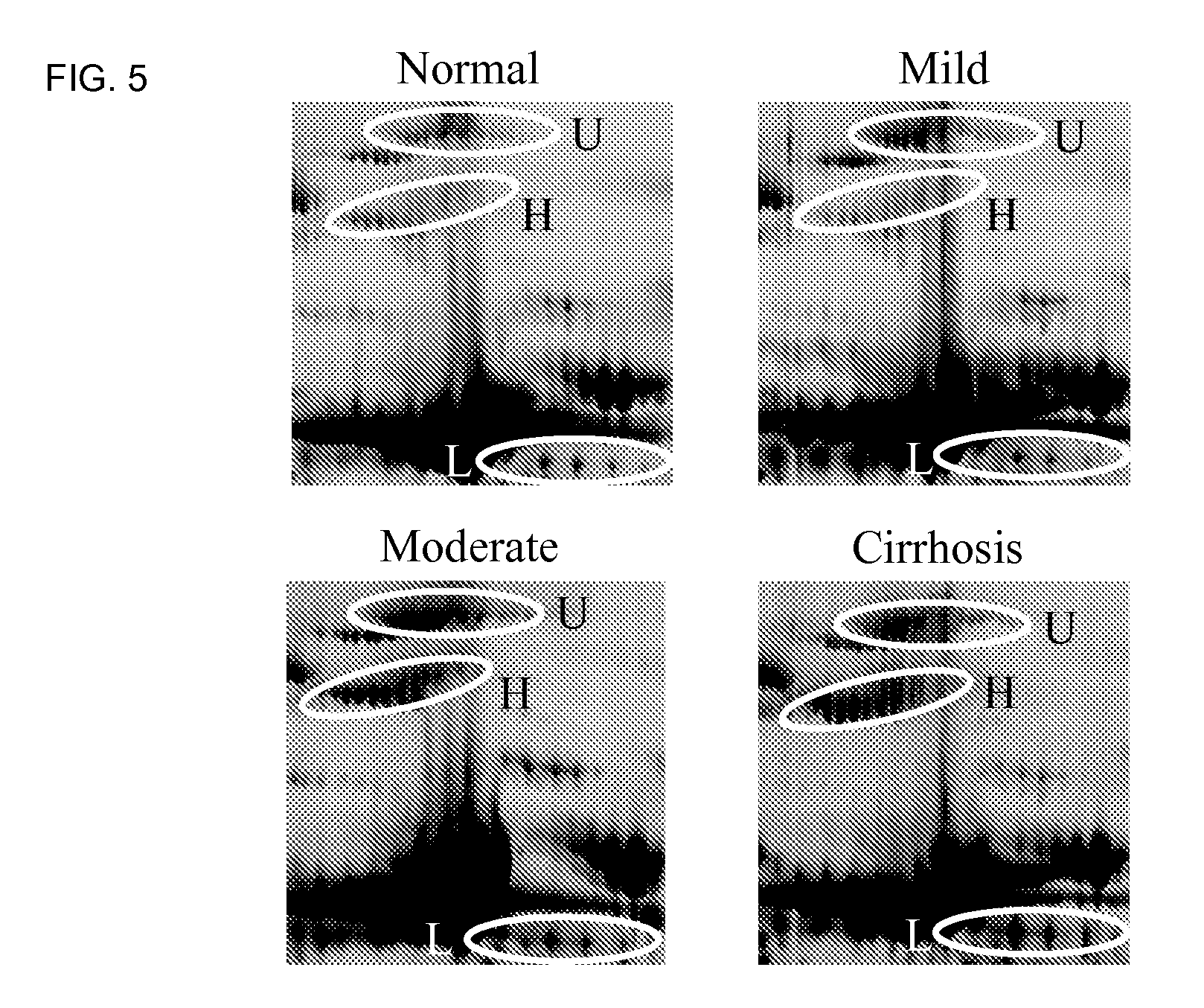Clinical diagnosis of hepatic fibrosis using a novel panel of human serum protein biomarkers
a human serum protein and diagnostic panel technology, applied in the field of clinical diagnosis of hepatic fibrosis using a novel panel of human serum protein biomarkers, can solve the problems of unreliable biopsy, patient discomfort, pain, bleeding,
- Summary
- Abstract
- Description
- Claims
- Application Information
AI Technical Summary
Benefits of technology
Problems solved by technology
Method used
Image
Examples
example 1
[0125]Two Dimensional Polyacrylamide Gel Electrophoresis (2D-PAGE)
[0126]To identify biomarkers for different stages of HCV-induced fibrosis, serum samples of healthy individuals and HCV-induced fibrosis / cirrhosis patients (15 individuals) were analysed in a 2D-PAGE-based proteomics study. 500 μg of serum proteins were separated by charge using a pH 3-10 non-linear gradient in the first dimension of the gel and by molecular weight (size) in the second dimension. Electrophoresis, fluorescent staining and scanning of gels were performed as described by Gangadharan et al., (2007), Clin. Chem., 53.
example 2
Differential Image Analysis and Protein Identification
[0127]The two dimensional array of spots generated were compared between normal and fibrosis / cirrhosis serum samples by computer-aided image analysis. Scanned images of all 2D-PAGE gels were analysed by computer-aided image analysis as described by Gangadharan et al., (2007), Clin. Chem., 53. Differentially expressed changes that were greater than or equal to 2-fold different were considered to be significant. A total of 53 differentially expressed features were excised, digested with trypsin, and analysed by mass spectrometry.
example 3
Identification of Human Serum Biomarkers for Hepatic Fibrosis Due to Cirrhosis
[0128]Differential image analysis revealed initial evidence for potential serum biomarkers. See FIGS. 1-5. The most prominent changes were observed when comparing serum samples from cirrhotic patients with healthy controls. This analysis showed that expression of inter-α-trypsin inhibitor heavy chain H4 fragments (ITIH4), α1 antichymotrypsin, apolipoprotein L1 (Apo L1), prealbumin and albumin was decreased in cirrhotic serum, whereas expression of CD5 antigen like protein (CD5L) and β2 glycoprotein I (β2GPI) increased. In general, α2 macroglobulin (a2M) and immunoglobulin components increased with hepatic fibrosis whereas α1, α2 and β chains of haptoglobin and complement components (C3, C4 and factor H-related protein 1) decreased.
[0129]
Patients with CirhosisDecreaseIncreaseinter-α-trypsinCD5 antigen like protein (CD5L)inhibitor heavy chainH4 fragmentsα1 antichymotrypsinβ2 glycoprotein I (β2GPI)apolipoprot...
PUM
| Property | Measurement | Unit |
|---|---|---|
| temperature | aaaaa | aaaaa |
| temperature | aaaaa | aaaaa |
| Tm | aaaaa | aaaaa |
Abstract
Description
Claims
Application Information
 Login to View More
Login to View More - R&D
- Intellectual Property
- Life Sciences
- Materials
- Tech Scout
- Unparalleled Data Quality
- Higher Quality Content
- 60% Fewer Hallucinations
Browse by: Latest US Patents, China's latest patents, Technical Efficacy Thesaurus, Application Domain, Technology Topic, Popular Technical Reports.
© 2025 PatSnap. All rights reserved.Legal|Privacy policy|Modern Slavery Act Transparency Statement|Sitemap|About US| Contact US: help@patsnap.com



